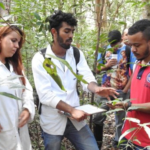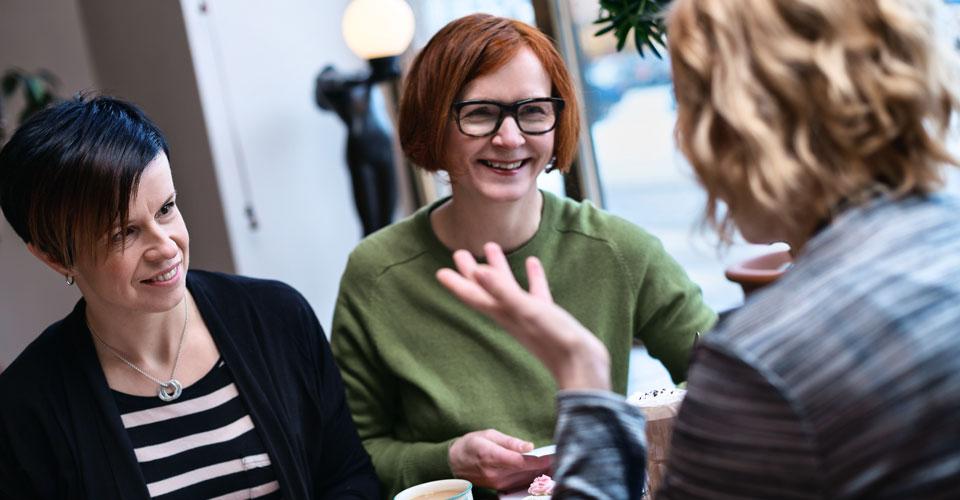
The Flipped Classroom model offers efficient and meaningful approach in Master’s Degree level studies in universities of applied sciences, but it demands careful planning, implementation, continuous assessment and many new efforts from teachers. Its strengths are in making the learning process more engaging, motivating and meaningful for autonomous adult learners, who study while working.
Introduction
The goal of this article is to offer theoretical founding and perspectives to the pedagogical model of the Flipped Classroom (e.g. Lage, Platt & Treglia 2000; Alvarez 2011; Strayer 2012) and to introduce the Flipped Classroom experiment and development project in Häme University of Applied Sciences (later referred to as HAMK). The pedagogical experiments are carried out in the process of the national project named “YAMK-koulutus vahvaksi TKI-vaikuttajaksi”, which is funded by the Ministry of Education of Finland. The objective of the project is to enhance the RD&I (Research, Development and Innovation) in the Master’s Degree -studies completed at the Finnish universities of applied sciences. Further, the goal of the project is to enhance and deepen the university-business co-operation and applied research with the world of work.
The first chapter of this article presents the theoretical approaches to pedagogical model of Flipped Classroom by referring to previous research and implementation reports on the theme. The attention has been payed especially to the higher education students’ experiences of studying with the methodology. The second chapter introduces the development and experiment process in HAMK and the results and conclusions of the project. The third chapter discusses future actions and future needs for research, education and co-operation with the world of work.
This article, together with the pedagogical pilot projects, research and several educational experiments run in the project (see e.g. Mäntylä 2015; Turunen & Valokorpi 2015; Miettinen & Vikberg-Aaltonen 2015; Valokorpi, Mäntyneva, Turunen, Ruusunen & Kullaslahti 2015) aims to offer material for university teachers and developers for studying, implementing and assessing high-quality training, new pedagogical methods and work-based applied research in their work. The article is chosen to be written in English for serving also the international studies and global education of HAMK. It will be implied also in learning material planning and design in near future.
1. The elements and definitions of Flipped Classroom
Flipped Classroom is an instructional strategy and a model of blended learning that reverses the traditional educational arrangement by delivering instructional content outside of the classroom. It usually includes technology-supported online activities. Instead of following teachers’ lectures in traditional classroom, students learn through variety of problem-based, activating tasks and projects outside of the classroom. Students build new knowledge actively, e.g. by watching online lectures, by collaborating in online discussions and acquiring new information from variety of sources and media. When meeting the instructor, they receive guidance and facilitation in their individual learning process and deepen the meaningful knowledge and concepts. (E.g. Abeysekera & Dawson 2015.)
Bishop and Vergler (2013) define Flipped Classroom as an educational technique that consists of two parts: interactive group learning activities inside the classroom, and direct computer-based individual instruction outside the classroom. Their definition is represented in Figure 1.
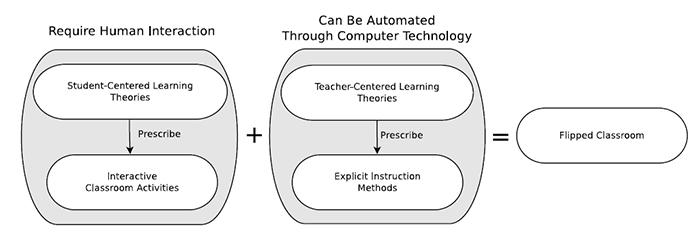
Strayer (2007, 28) instead, develops a wider conceptual framework for investigating learning activity in a classroom that is structured using the classroom flip. Also he is emphasizing the extensive use of educational technology to deliver course content outside of class, but he reminds that active learning during class time is the other necessary feature of the classroom flip (Strayer 2007). These two elements influence on student’s learning environments in fundamental ways (see in Figure 2.)
The Learning environments includes also relationship and personal dimensions as well as system maintenance and change.
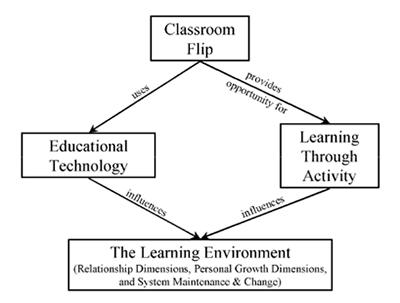
While often defined simplistically as “school work at home” and “home work at school”, Flipped Classroom is a pedagogical approach that allows teachers to implement a student-centered, activating methodology, or various methodologies, in their teaching (Flip Learning n.d.).
In addition to many scientific research and theoretical concept development, also many popularized reports open the instructional model of Flipped Classroom for educators. For example, Knewton Infographics present the visualization of Flipped Classroom on the basis of Strayer (2011) and Khan Academy (n.d.). Figure 3 presents the change in teacher’s role in Knewton Infography. Teacher’s role changes from traditional “Sage on the Stage” to “Guide on the Side”.

1.1 The four pillars of Flipped Learning
The Flipped Classroom Network distinguishes between a Flipped Classroom and Flipped Learning. The Network states that many teachers may already flip their classes by having students read text outside of class, watch supplemental videos, or solve additional problems, but to engage in Flipped Learning, teachers must incorporate the following four pillars into their practice: 1) Flexible Environment, 2) Learning Culture, 3) Intentional Content and 4) Professional Educator (Flipped Learning Network 2014). The Flexible Learning Environment means that teachers often physically rearrange their learning spaces and create flexible spaces in which students choose when and where they learn. Furthermore, educators who flip their classes are flexible in their expectations of student timelines for learning and in their assessments of student learning.
The Learning Culture means student-centered approach where in-class time is dedicated to exploring topics in greater depth and creating rich learning opportunities. Students are actively involved in knowledge construction as they participate in and evaluate their learning in a manner that is personally meaningful. Intentional Content means that educators maximize classroom time in order to adopt methods of student-centered, active learning strategies, depending on grade level and subject matter. Intentional Content means, that teachers continually think about how they can use the Flipped Learning model to help students develop conceptual understanding, as well as procedural fluency. Teachers determine what they need to teach and what materials students should explore on their own. Educators use intentional, meaningful content to maximize classroom time in order to adopt methods of student-centered, active learning.
The role of a Professional Educator is even more important, and often more demanding, in a Flipped Classroom than in a traditional one. During class time, teachers continually observe their students, providing them with feedback relevant in the moment, and assessing their work. Professional educators are reflective in their practice, connect with each other to improve their instruction, accept constructive criticism, and tolerate controlled chaos in their classrooms (Flipped Learning Network 2014).
1.2 The challenges of Flipped Classroom
Herreid and Schiller (2013) have revealed that there are also challenges and pitfalls in the Flipped Classroom. The two major problems are 1) student resistance and 2) finding good, quality online learning materials, e.g. videos. Students new to the method may be initially resistant because it requires that they do work at home rather than be first exposed to the subject matter in school. Consequently, they may come unprepared to class to participate in the active learning phase of the course. Faculty solve this problem by giving a short quiz either online or in class or by requiring homework that references information that can only be obtained from the outside reading or videos (Herreid & Schiller 2013, 2).
The homework (e.g. readings, videos) must be carefully tailored for the students in order to prepare them for the in-class activities. For most teachers and students, videos are the method of choice for delivering the out-of-class portion of the instruction. However teachers experience that finding good quality videos is difficult. The quality of the teacher-created videos is often marginal and creating them requires a significant amount of time (Herreid & Schiller 2013, 2).
1.3 Students’ perceptions about Flipped Classroom
Many researchers have revealed benefits of Flipped Classroom from the students’ point of view and learning experiences. For example students in three high schools’ math classrooms, where instruction was flipped, were surveyed to examine their perceptions of the Flipped Classroom. The students reported enjoying learning more, achieving higher results, yet doing less homework in the Flipped Classroom than in the traditional classroom (Johnson 2013).
Also Murray, Koziniec and McGill (2014) have recently studied high school IT-students’ perceptions about Flipped Classroom. They found that students were generally positive about the approach, particularly the convenience and flexibility of the flipped videos. Although face to face teaching time was reduced in this learning implementation, students felt that they interacted more with their instructors and peers. Students felt also strongly positive to walkthroughs and were mixed as to the need for the instructors face. Although significant efforts were made to produce high quality and engaging videos, the survey suggested that students, however, learnt the most during teachers’ tutorial time. The researchers conclude, that the relative importance of interactive tutorials is congruent with a large body of research and pedagogical approaches advocating the importance of active student-centered learning (Murray, Koziniec & McGill 2014).
1.4 Lessons learned from previous Flipped Classroom -studies
The previous research of Flipped Classroom show that the method is demanding and need careful planning from educator. Although the method is seen very positive because its’ activating and knowledge constructing nature (Abeysekera & Dawson 2015; Alvarez 2011) some studies reveal also problems in method. For example Johnson & Renner (2012) have studied the efficacy of traditional and flipped course delivery in high school methods using a mixed-methods switching replications design. In their study, it was hypothesized that students in the computer applications class would benefit from the flipped method due to the transitioning of class time from lower-level activities to collaborative group work. The study results didn’t support this hypothesis and the researchers concluded to offer lessons learned about the flipped class (Johnson & Renner 2012, 44–46):
- The expectation of spending time doing homework should be clear. If there is not a routine or culture where homework is required, this will be a primary barrier to achieving the goal. Possible accommodations might include open labs before and after school.
- A flipped class implementation does not have to be all or nothing. Teachers can flip selected lessons. The flip is one instructional strategy, not a curriculum or stand-alone pedagogy. Teachers might experience positive results flipping lessons on occasion.
- Students do not automatically prefer cooperative group work, nor do they intuitively know how to work in a group successfully. A flipped lesson where students work in isolation still makes effective use of class time, because the teacher is available for further explanation and individual conferencing. There is still benefit to receiving the instruction before class. While Howe and Strauss (2000) document that Millennials prefer teamwork and cooperation, it is important to honor differences. If a collaborative learning environment is to be achieved, Johnson and Johnson (2009, 369) state that, students must be taught the interpersonal and small-group skills needed for high-quality cooperation and be motivated to use them.
- Lecturing is not bad pedagogy, but it should not be the primary or sole means for instruction. Lecturing can still be in many ways an efficient form of conveying large quantities of information, especially when it is carefully planned and includes activating elements to students. Providing access to lecture content via technology does more than free up class time. It allows students to view or hear lessons multiple times. The flip balances the requirement of covering content with the opportunity to apply the theory being learned (Toto & Nguyen 2009).
2. Development of Flipped Classroom model in HAMK
The goal of HAMK is to further develop the studying process of the Master’s Degrees more flexible and working-life oriented. The aim is to increase the adult learners’ own responsibility and autonomy in their learning process, as well as to offer research and development possibilities for regional industries, businesses and employers. In “Creating a strong R&D profile for Master’s Degree programmes” project the studies were redesigned and reformed from teacher-centered lecturing to student-centered learning by implementing the Flipped Classroom model, and in addition, the Scrum model (Schwaber & Sutherland 2013; Larman 2004) in learning. The Scrum model emphasizes the teamwork, clearly defined learning tasks, daily team meetings and one-month learning sprint sections. The Scrum process is agile, iterative and includes transparency, follow-ups and continuous modification and development of the process.
The Business Management and Entrepreneurship -Master’s Degree Programme scores 90 credits and it’s organized modularly with support of online guidance and facilitation. The Master Degree takes approximately 2,5 years and it’s possible to accomplish completely in addition to working duties. The thesis of the studies scores 30 credits and concentrates of the real and authentic development needs of a student’s working life or an employer.
The Flipped Classroom model, supported by Scrum approach, was piloted in the Organizational Development module (15 credits) of Business Management and Entrepreneurship Degree Programme (“Liiketoiminnan kehittäminen” in Finnish) in separated Finnish and English study groups. There were altogether 69 students studying in the modules and testing the Flipped Classroom method in the pilot phase in Autumn 2014. The Organizational Development module consists of three thematic areas, Future working life and working community skills, Knowledge management in online environments and Communication skills, which have all their own responsible teacher. The three teachers of thematic areas plan, implement and evaluate the whole module together. The Flipped Classroom model was assessed to fulfill the needs of students especially within this specific, working-life oriented module: the teachers had earlier analyzed the course implementation and recognized that students wish to concentrate more on their current working life challenges in learning. In addition, the students needed more flexibility in studying while working.
2.1 The pedagogical redesign of the Organizational Development -module
At first, the entity of the module was re-designed with student-centered, activating and engaging approach. It was realized, that an adult learner must own her own learning process and take actively responsibility of her actions. According to Scrum framework, the students were encouraged to take the roles of the process owners who define themselves the learning goals and the challenge or problem they need to find solutions. Students also planned their own learning processes including concrete timetable, milestones and assessment of the process. The teachers guided students to create the development teams who, after a shared assignment statement and kick-off, made a concrete plan how and what to study in their next learning sprint section. Miikka Ruusunen has visualized the learning spring section in Figure 4. The visualization presents bot teachers’ and students’ actions during one month studying. The sprint section is implemented three or four times in one module.
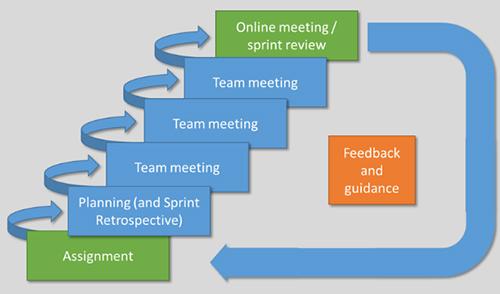
In the both study groups, the English and the Finnish, the students worked on their learning tasks in online and organized also in their weekly team meetings in the web. The meetings were all documented regularly. There were four to five students in each development team and the same teams co-worked through the whole module, the three different thematic areas. In addition to online working, the English study group met also face-to-face once in a month.
The constant follow-up and evaluation of the online learning process was very important in the process. The students assessed their own learning projects and also the work of their development teams. Both Finnish and English groups used variety of online tools in their studying. For example Microsoft Office 365 -service was used in shared workspaces, timetabling and milestoning the learning process, as well as in negotiating about the contents and learning achievements. The online learning process was decided to keep as transparent as possible so, that both teachers and students can follow the process openly and comment also the unfinished tasks under processing.
The teachers concluded that the new pedagogical method asks rehearsing and learning not only from the students but also from the teachers. The teachers need to communicate more and negotiate about the key contents and the learning goals of the shared teaching. The constant planning, assessing and monitoring learning is needed in Flipped Classroom -model.
The role of the teachers was important in facilitating, activating and assessing the Flipped online learning process. The teachers individualized the students’ learning by offering personal deepening knowledge, for example learning materials, sources and references. However, the students were responsible to collect, modify and edit their own learning materials in the process. Teachers also encouraged the students to share openly their knowledge with other students.
According to Flipped Classroom model, the students built the knowledge flexibly, independently but also in co-operation with their peers. In their weekly meetings the students collaborated and concentrated on their current challenges and questions. The students’ role as co-learners and peers was important and emphasized in the process. Although the teachers were active and available in online, they didn’t participate in the students’ weekly online meetings.
2.2 The students’ and the teachers’ feedback on Flipped Classroom model
According to the midterm feedback, the students considered the studying, redesigned with Flipped Classrom model and Scrum framework, far more efficient than the traditional training with lecturing. The flexibility of studying, planning your own timetable and concentrating on authentic working-life questions were considered very positive. The students appreciated especially the effective use of time resources. The students had also suggestions for improvement: they wished to have more detailed feedback and guidance from their teachers. The open tasks, such as learning goal setting, wasn’t easy for all. The students also wished to have more supportive and tailored learning materials such as video clips on most demanding new concepts. These improvements are included in module implementations in near future.
The teachers assessed their experiments in the process as well. They were content with the process results, especially with the fact that students achieved their learning outcomes as it was planned. However, the teachers felt that they could not so easily track and assess each and everyone’s learning process in detail. The teachers recognized that the Flipped Classroom model enhanced students’ autonomy and responsibility in their studying. The method offers also general learning and working skills to students; they learn to co-operate, negotiate, lead themselves and teams while studying. The knowledge created in learning tasks was also relevant from the point of view of working life. Still, the teachers spotted several new needs for development in next phase. At first, the learning tasks needed to include more authentic problem-solving. Secondly, the teachers and students need to be more aware about the possible risks of learning. The risks are, for example, connected to capabilities to use new online tools, to deal with technical problems, and also to the ability to commit to open and flexible learning process.
The teachers concluded that the new pedagogical method asks rehearsing and learning not only from the students but also from the teachers. The teachers need to communicate more and negotiate about the key contents and the learning goals of the shared teaching. The constant planning, assessing and monitoring learning is needed in Flipped Classroom model. The strengths and challenges of Flipped Classroom model experienced in pilot project are summed up in following Table 1.
Table 1. The strengths and challenges of Flipped Classroom model experienced in pilot project.
| Strengths | Challenges |
|---|---|
| 1 Motivating, engaging, efficient | 1 Requires more planning, co-operation and material production from teachers |
| 2 Supports students’ autonomy, responsibility and ownership of learning | 2 The individualized learning processes need efforts in facilitation and guidance |
| 3 Authentic, real-life problem-solving is meaningful for the students and the world of work | 3 New approach may be demanding for some students at the beginning |
3. Future actions and needs for research
As a conclusion, one can say that the Flipped Classroom model offers efficient and meaningful approach in Masters Degree -level studies in universities of applied sciences, but it demands careful planning, implementation, continuous assessment and many new efforts from teachers. Its strengths are in making the learning process more engaging, motivating and meaningful for autonomous adult learners, who study besides of working. Further, the model supports students to deepen their knowledge on relevant questions related to their own work. At its best the model develops not only the knowledge but the skills and competences students need in their work: responsibility-taking, communication skills and systematic planning.
The future challenge for Master Degree -developers is to strengthen even more the relationships with the regional industries, businesses and employers, and involve them in planning competence development, and learning process of the students – their own employee. Further, how the pedagogically redesigned Master Degree -programme could offer an innovative development platform for the research and development initiatives with working life? How to map and find out the current challenges and problems of industries and businesses? How teachers could facilitate and guide innovative and new-generating learning processes together with the working life representatives? How to benefit the authentic learning environments of the students even more in the Flipped Classroom model?
References
Abeysekera, L. & Dawson, P. (2015). Motivation and cognitive load in the flipped classroom: definition, rationale and a call for research. Higher Education Research & Development 34(1), 1–14.
Alvarez, B. (2011). Flipping the classroom: Homework in class, lessons at home. Education Digest: Essential Readings Condensed For Quick Review, 77(8), 18–21.
Bishop, J. L., & Verleger, M. A. (2013). The flipped classroom: A survey of the research. Paper presented at the American Society for Engineering Education, Atlanta, GA.
Flip Learning (n.d.). A community resource brought to you by the Flipped Learning Network. Retrieved September 27, 2016, from http://flippedlearning.org/
Flipped Learning Network (2014). Definition of Flipped Learning. Retrieved September 22, 2016, from http://flippedlearning.org/definition-of-flipped-learning/
Herreid, C.F. & A.Schiller, N. (2013). Case Studies and the Flipped Classroom. Journal of College Science Teaching. 42(5), 62–66.
Howe, N., & Strauss, W. (2000). Millennials rising: The next great generation. New York, NY: Random House.
Johnson, D. & Johnson, R. (2009). An educational psychological success story: Social interdependence theory and cooperative learning. Educational Researcher, 38, 365–379.
Johnson, G. B. (2013). Student perceptions of the Flipped Classroom. University of British Columbia, Retrieved September 22, 2016, from https://circle.ubc.ca/handle/2429/44070?show=full
Johnson, L.W. & Renner, J. D. (2012). Effect of the flipped classroom model on a secondary computer applications course: Student and teacher perceptions, questions, and student achievement. Unpublished doctoral dissertation. University of Louisville, Kentucky. Retrieved September 22, 2016, from http://theflippedclassroom.files.wordpress.com/2012/04/johnson-renner-2012.pdf
Khan Academy (n.d.). You only have to know one thing: you can learn anything. Retrieved September 27, 2016, from https://www.khanacademy.org/
Knewton Infographics (n.d.). Flipped Classroom. Retrieved September 22, 2016, from http://www.knewton.com/flipped-classroom-2
Lage, M., Platt, G. & Treglia , M. (2000). Inverting the Classroom: A Gateway to Creating an Inclusive Learning Environment. Journal of Economic Education, 31(1), 30–43. Retrieved September 22, 2016, from http://www.jstor.org/stable/1183338
Larman, C. (2004). Agile & Iterative Development. A Manager’s Guide. Boston: Addison-Wesley.
Miettinen, S. & Vikberg-Aaltonen, P. (2015). Tutkimusryhmä YAMK-oppimisympäristönä. In M. Lampinen & H. Turunen (eds.) YAMK-koulutus vahvaksi TKI-vaikuttajaksi. HAMKin e-julkaisuja 29/2015, 14. Retrieved September 22, 2016, http://urn.fi/URN:ISBN:978-951-784-761-2
Murray, D., Koziniec, T., McGill, T. (2014). Student Perceptions of Flipped Learning,In: 17th Australasian Computer Education Conference (ACE 2015), Retrieved September 22, 2016, from
http://profiles.murdoch.edu.au/myprofile/david-murray/files/2012/06/Flipped_Learning.pdf
Schwaber, K. & Sutherland J. (2013). The Scrum Guide. The Definite Guide to Scrum: The Rules of the Game. Retrieved September 22, 2016, from http://www.scrumguides.org/docs/scrumguide/v1/scrum-guide-us.pdf
Strayer, J. F. (2007). The effect of the classroom flip on the learning environment: A comparison of learning activity in a traditional classroom and a flip classroom that used an intelligent tutoring system. Ph.D. Thesis. Columbus: Ohio State University.
Strayer, J. F. (2011). The Flipped Classroom. Retrieved September 27, 2016, from https://www.knewton.com/infographics/flipped-classroom/
Strayer, J. F. (2012). How learning in an inverted classroom influences cooperation, innovation and task orientation. Learning Environments Research, 15 (2), 171–193. Retrieved September 22, 2016, from http://www.colorado.edu/ftep/sites/default/files/attached-files/strayer_–_inverted_classroom_influences.pdf
Toto, R., & Nguyen, H. (2009). Flipping the work design in an industrial engineering course. Paper presented at the ASEE/IEEE Frontiers in Education Conference, San Antonio, TX.
Turunen, H. & Valokorpi, P. (2015). Käänteinen oppiminen ylemmän ammattikorkeakouluopiskelun uudistajana. Esitys, Peda-forum-päivät 20.–21.8.2015, Helsinki.
Valokorpi, P., Kullaslahti, J., Mäntyneva, M., Ruusunen, M. & Turunen, H. (2016). Ketterästi käänteisessä luokkahuoneessa – sulautuvaa opetusta, yhteisöllistä oppimista ja tiimiopettajuutta: Työelämätaidot- ja Organisational development -moduulien pilottitoteutukset. In T. Joutsenvirta & L. Myyry (eds.) Sulautuvaa opetusta, käänteistä oppimista. Valtiotieteellisen tiedekunnan opetuksen kehittämispalvelut. Helsinki: The University of Helsinki. Retrieved September 27, 2016, from https://helda.helsinki.fi/bitstream/handle/10138/161884/SULOP2016.pdf
Authors
Essi Ryymin is a Principal Lecturer, Ph.D. (education) at Häme University of Applied Sciences, Finland, and a Research Manager of the Global Education R&D -team.
Jaana Kullaslahti, Ph.D (Education), M.Sc (Nutrition) is a Principal Lecturer and a Manager of Research Group, Digipedagogical competence at Häme University of Applied Sciences, Finland.
Mikko Mäntyneva, is a Principal Lecturer, PhD (Econ.) focusing on Master’s studies in Business Administration at Häme University of Applied Sciences, Finland, and a Research Manager at its Smart Services Research Unit.
Miikka Ruusunen is an ICT Project Manager, Master of Business Administration, at Häme University of Applied Sciences, Finland.
Pirjo Valokorpi is a Principal Lecturer, Lic (Phil) in the Master’s Degree at Häme University of Applied Sciences, Finland.
Helena Turunen is a Principal Lecturer, Dr Sc (Econ) at Häme University of Applied Sciences, Finland.
Brian Joyce is a Senior Lecturer, M.A. (online and distance education) at Häme University of Applied Sciences, Finland, and a CLIL Specialist (content and language integrated learning).
Reference to the publication:
Ryymin, E., Kullaslahti, J., Mäntyneva, M., Ruusunen, M., Valokorpi, P., Turunen, H. & Joyce, B. (2016). Flexible and Agile Studying in Master’s Degree – Experiences on Flipped Classroom in the University of Applied Sciences. HAMK Unlimited Journal 27.9.2016. Retrieved [date] from https://unlimited.hamk.fi/ammatillinen-osaaminen-ja-opetus/flexible-and-agile-studying-in-masters-degree-experiences-on-flipped-classroom-in-the-university-of-applied-sciences/
http://urn.fi/URN:NBN:fi-fe2020111991940

This material is CC licensed Attribution-ShareAlike 4.0 International.
[button href=”http://www.hamk.fi/english/applicants/business-management-and-entrepreneurship/Sivut/default.aspx” target=”_blank” bg_color=”#FF0066″ text_color=”#ffffff”]Business Management and Entrepreneurship »[/button]


